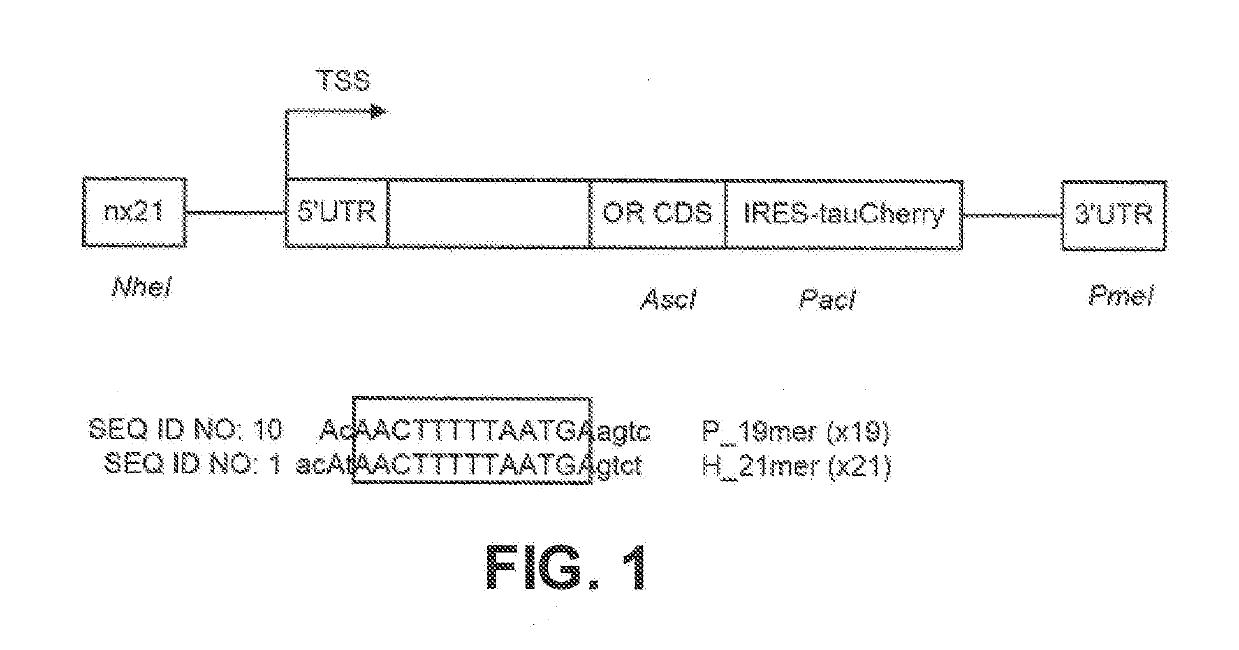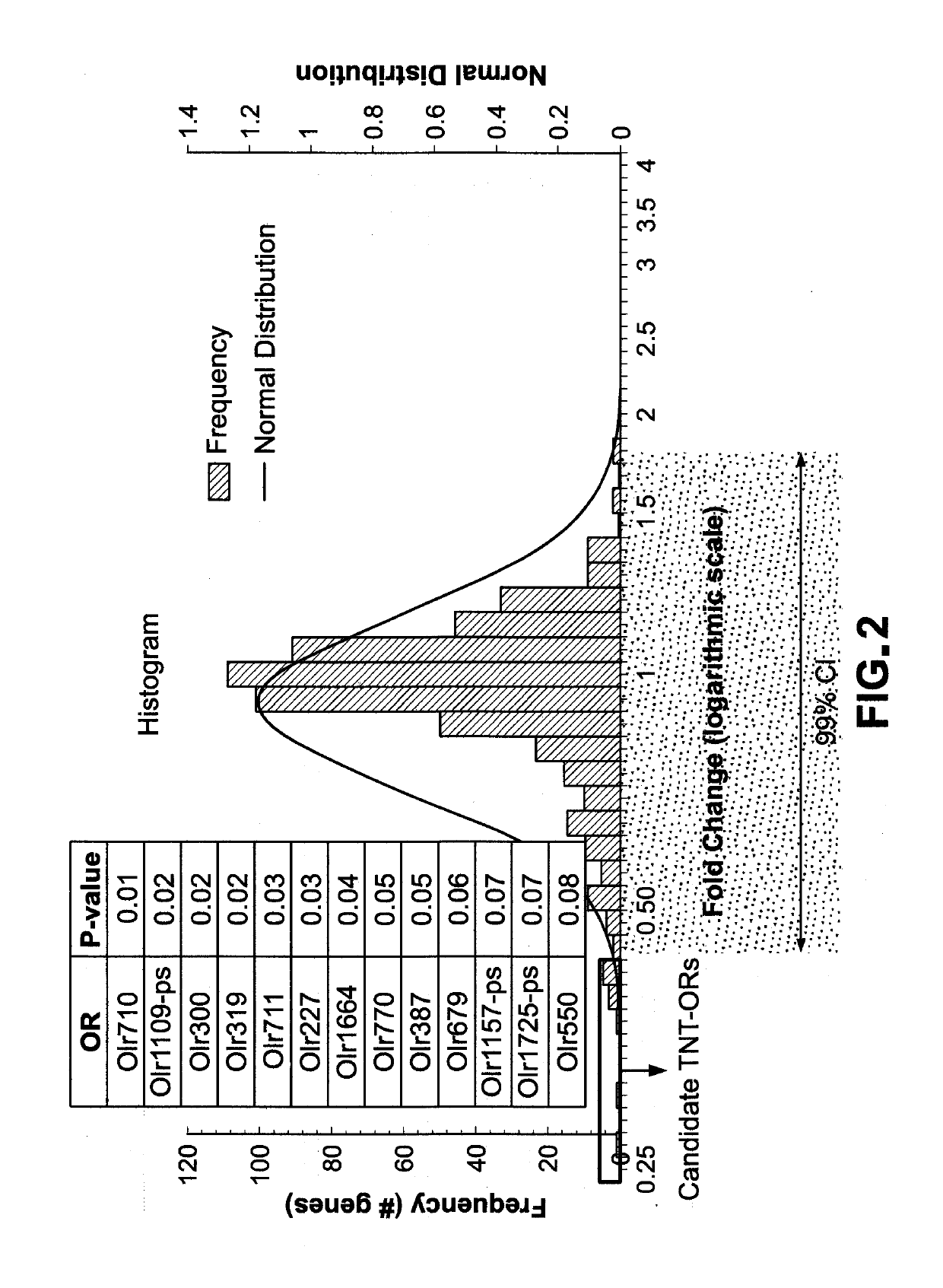Biosensor exhibiting sensitivity to trinitrotoluene
a biosensor and trinitrotoluene technology, applied in biochemistry apparatus and processes, instruments, chemical indicators, etc., can solve problems such as anemia and abnormal liver function, inability to express functional odorant receptors in vitro using mammalian cell lines, and toxic tnt to a variety of ways
- Summary
- Abstract
- Description
- Claims
- Application Information
AI Technical Summary
Benefits of technology
Problems solved by technology
Method used
Image
Examples
example 1
Identification of TNT-Responsive ORs in Rat
[0037]The discriminatory power of odorant receptors rivals that of the visual and auditory systems, but the patterns of receptor activation by odorant ligands remains elusive. Resolution of this problem has been hampered by the vast amount of ORs expressed in the mammalian nose (greater than 1200 in rats and mice, about 400 in human) and by the fact that odorant receptors are notoriously hard to express in vitro, making high-throughput ligand profiling screen impossible. For these reasons, less than 10% of all odorant receptors have a known ligand and most odorant receptors remain orphans, meaning that their correspondent ligands are unknown.
[0038]To identify the odorant receptors that are activated by TNT, a technique called “DREAM” (i.e. Deorphanization of Receptors based on Expression Alterations of mRNA levels) was used, which takes advantage of the generalized reduction in odorant receptor mRNA concentration that occurs after specific ...
example 2
Identification of TNT-Responsive ORs in Mouse
[0045]TNT DREAM analysis was also performed on mice (Mus musculus, n=7) using the same protocol described above. The mouse TNT-responsive OR genes that were identified are listed in Table 3. A non-exhaustive list of homologs and orthologues of mouse TNT-responsive ORs based on homology of 85% or more can be found in Table 4 (all NCBI Gene IDs, as well as NCBI mRNA and protein accession numbers are incorporated herein by reference).
TABLE 3Mouse TNT-responsive ORs identified in this applicationGene name(Mus NCBINCBI mRNANCBI ProteinSEQ IDmusculus)Gene IDAccession No.Accession No.NO:Olfr297258611NM_146618.2NP_666829.25Olfr597258135NM_001011845.2NP_001011845.216Olfr605258156NM_001011854.2NP_001011854.217Olfr566258168NM_001011536.1NP_001011536.118
TABLE 4Homologs of mouse TNT-responsive ORs identified in this applicationMOUSERATGeneGeneNCBINCBI mRNANCBI Protein namenameGene IDAccession No.Accession No.Olfr297olr30293091NM_001000120.1NP_00100012...
example 3
Generation of a Transgenic Mouse Preferentially Expressing a TNT-Responsive OR
[0047]TNT-responsive OR genes are designed with MluI restriction sites flanking the two ends and synthesized as sequence-verified, double-stranded DNA fragments. These DNA fragments are digested with MluI and ligated into the MouSensor vector (˜9 kB) (as described in D'Hulst et al. 2016) digested with AscI. Ligated constructs are transformed into DH5alpha Escherichia coli cells, and positive clones are grown for plasmid purification. To create constructs expressing different fluorophores (i.e. mVenus, mTeal), the MouSensor-OR constructs are digested with PacI to isolate the OR fragment and ligated into a PacI-digested MouSensor vector containing genes encoding the mVenus or mTeal fluorophores. The final constructs (˜10 kB) are digested with PmeI to linearize for pronuclear injection, in which the DNA randomly integrates into the mouse genome. For this, purified DNA is microinjected into a fertilized oocyte...
PUM
| Property | Measurement | Unit |
|---|---|---|
| Fraction | aaaaa | aaaaa |
| Fraction | aaaaa | aaaaa |
| Fraction | aaaaa | aaaaa |
Abstract
Description
Claims
Application Information
 Login to View More
Login to View More - R&D
- Intellectual Property
- Life Sciences
- Materials
- Tech Scout
- Unparalleled Data Quality
- Higher Quality Content
- 60% Fewer Hallucinations
Browse by: Latest US Patents, China's latest patents, Technical Efficacy Thesaurus, Application Domain, Technology Topic, Popular Technical Reports.
© 2025 PatSnap. All rights reserved.Legal|Privacy policy|Modern Slavery Act Transparency Statement|Sitemap|About US| Contact US: help@patsnap.com



